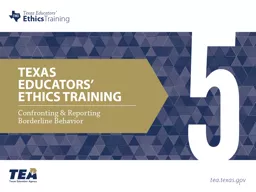

2 Stimulating Thinking What is my role in reporting inappropriate behavior 3 Caring and Committed Educators 4 Impact of Educator Misconduct 5 Photos courtesy of TEA Educator Investigations Unit training ID: 714752
Download Presentation The PPT/PDF document "1 Purpose Explore the responsibility of ..." is the property of its rightful owner. Permission is granted to download and print the materials on this web site for personal, non-commercial use only, and to display it on your personal computer provided you do not modify the materials and that you retain all copyright notices contained in the materials. By downloading content from our website, you accept the terms of this agreement.
Slide1
1Slide2
Purpose
Explore the responsibility of educators in identifying and reporting inappropriate behaviors.
2Slide3
Stimulating Thinking
What is my role in reporting inappropriate behavior?
3Slide4
Caring and Committed Educators
4Slide5
Impact
of Educator Misconduct
5Slide6
Photos courtesy of TEA Educator Investigations Unit training
s
ession
ARRESTED
6Slide7
What does borderline behavior mean?
7Slide8
Keep me safe.
8Slide9
A Common Occurrence
“When I talk to teachers in a school where an educator has been arrested, I hear admissions that they suspected something but, because they were not completely sure, did not want to say anything.
”
(Shakeshaft, 2013)
9Slide10
Educators can
confront misconduct
, specifically sexual
misconduct,
in schools if they know how to recognize and respond to suspicious patterns. (Shakeshaft
, 2013)
10Slide11
11Slide12
Lack-of-Judgment Pattern
Don’t initially set out to harm students
E
nd up in relationships with students to meet emotional needs
12Slide13
The Slippery Slope
Voluntary statement given
during investigation:
“Why did I act this way? I honestly don
’
t know. I think it had a lot to do with two things: extreme loneliness and severe depression.”
“Basically, I have no friends, certainly none in this town. This is probably the reason I’m so
depressed. I started to feel closeness with her and
was drawn to it. I don’t know what I was thinking.”
13Slide14
14Slide15
Reporting is Everyone’s Responsibility
“I typically remain in my classroom until 5:30 or 6 most afternoons to grade papers, gather lesson resources, etc.
Walking to my car, I frequently observed a teacher leaning against her car engaged in conversation with one of my eighth-grade students
.
I often left feeling uneasy. It didn’t appear appropriate for this teacher to be chatting with the student in this manner. Their proximity seemed flirtatious. Usually, there were only two cars left in the parking lot: mine and hers.
Two months later, the teacher was suspended for having an inappropriate relationship with the student. Ultimately, she lost her job, and the student transferred to another school. I should have reported what I had observed to my principal. Now it’s too late.”
15Slide16
Rise in Cases of Educator Misconduct
16Slide17
17Slide18
Professional Responsibility
Professional Responsibility
18Slide19
Many students become victims of some type of educator misconduct.
19Slide20
“If I reported and I was wrong, I would have ruined the life of another
teacher.
”
(Shakeshaft
,
2013)
20Slide21
“If I
didn’t
report and
this person had abused, I’d have ruined
the life of a student.”
(Shakeshaft, 2013)
21Slide22
How do I distinguish between what is and isn’t a reportable offense?
22Slide23
Findings
Reasons some educators give for not reporting suspected educator misconduct:
Lack of recognition of characteristics associated with inappropriate/abusive behavior
Lack of awareness of legal responsibilities
Fear of negatively affecting the school or educator’s job
23Slide24
Findings
Reasons some educators give for not reporting suspected educator
misconduct:
Lack of sufficient evidence
Belief that the student will be harmed more than helped if reported
Fear of retaliation and litigation
24Slide25
If you suspect or know something . . .
25Slide26
What do we need to know about the reporting process?
26Slide27
Report suspected incidents of educator
misconduct to
your administrator
immediately.
District Reporting Protocol
27Slide28
District Reporting Protocol
Follow district reporting policies and procedures to ensure all appropriate steps are followed.
28Slide29
Supporting a Safe and Ethical Climate
Enforce a zero tolerance policy regarding
professional misconduct.
Strengthen policy guidance in identifying, reporting, and investigating incidents, if applicable.
Provide awareness training.
(Shakeshaft
,
2013
)
Follow
through
when confronted with questionable educator behavior
.
29Slide30
Are there reporting requirements for superintendents?
YES
30Slide31
Superintendent SBEC Reporting Requirements
Within
business
days, a superintendent must report
educator misconduct that results in termination or resignation; and
a reported criminal history of an applicant for or holder of a certificate or permit issued by SBEC.
31Slide32
Become knowledgeable about the importance of reporting requirements.
Create a safe and ethical climate.
Send a strong message that misconduct
will not be tolerated.
Trust your instincts
32